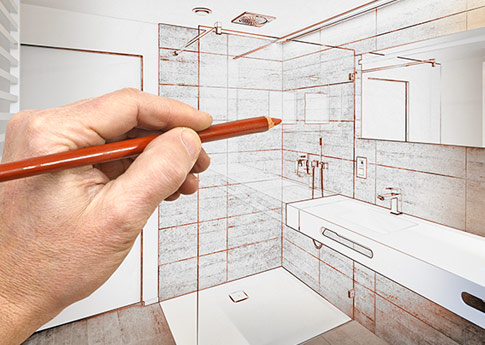Renovating your bathroom for comfort and functionality

Could your bathroom use a refresh? Here are a few tips to make your project go smoothly, for a bathroom that’s both functional and comfortable, even if it’s small.
Planning: The key to success
Before contacting building contractors for a quote, set your budget (does the project qualify for a subsidy program?) and draw up a complete plan, taking into account each family member’s needs and habits as well as any problems in your current bathroom (moisture, lack of storage, poor lighting, etc.).
Consider the dimensions and clearances. Examples of suggested minimum clearances:
- 30 in. in front of the tub, shower, vanity, and toilet
- 12 in. on each side of the toilet
- 32 in. for the height of the vanity
For major projects, such as removing a load-bearing wall, call on a specialist who is a member of a Quebec professional order (engineer, architect, etc.).
Of course, check with your municipality to see if a permit is required. A permit will certainly cost you less than a fine!

What is the best flooring for a bathroom?
Ceramic and porcelain floors are moisture resistant, durable, and easy to clean. However, they can be slippery when wet. Consider non-slip tiles. Vinyl tiles and linoleum are affordable options. For superior thermal comfort, consider a heated floor. It distributes heat evenly, doesn’t take up valuable space, and helps dry up the floor, reducing the risk of slipping and mould growth.
Tip: Install an uncoupling membrane under the floor tiles and a waterproofing membrane behind the shower tiles to prevent water damage. These membranes are waterproof, unlike ceramic grout.
How to choose a bathtub, shower, toilet, and sink
Of course, plumbing fixtures are the centrepiece of any bathroom. Not only are they expensive, they’re hard to change, so it’s very important to choose the right ones and consider quality.
- A bathtub that’s too high or too big is a classic mistake. Freestanding tubs are popular, but they’re more expensive than built-in models and aren’t for everyone: they require more space, more water, and aren’t practical for kids.
- A ceramic tile shower requires careful installation to ensure a perfect seal.
- As for the toilet, opt for a tall unit with an elongated bowl.
- For sinks, consider installing two to simplify morning and evening routines.
When it comes to materials, think long-term and choose classic, durable, moisture- and water-resistant products in neutral colours that will stand the test of time.
Tip: To save money and the environment, select a low-flow shower head and toilet and faucets with aerators. Be aware that low-flow toilets are not suitable for basement bathrooms.
Must-have bathroom fittings
For the shower head, you’ll want a column with a slide bar that adjusts to user height, and a thermostatic valve to preset the water pressure and temperature, to prevent sudden temperature changes when someone runs water in the house while you’re in the shower. If you’re considering a rainfall shower head, make sure it’s big enough to provide the desired effect. For sinks, electronic faucets are an attractive option because they’re hygienic and prevent water wastage (but just remember you’ll need to replace the batteries every so often!). Make sure there’s enough clearance between the sink and the tap.
For a well-lit bathroom
Install at least three lighting sources:
- A sconce on either side of the mirror, for makeup and shaving
- Multiple recessed or track lights in the middle of the room to illuminate specific areas
- Recessed fixtures for the shower
Tip: Consider getting lighting sources with dimmer switches to create the desired mood, such as soft lighting for bath time.
Which paint to choose
Select a paint designed specifically for bathrooms. It contains a fungicide that protects against moisture and mildew. Choose lighter colours to make the room brighter, since bathrooms generally have fewer windows and very opaque window treatments for privacy.
Choosing the right bathroom fan
To control excess moisture, choose a mechanical air extractor powerful enough for your needs. Consider the type and number of bathroom fixtures, peak use, the room size, and the length of the exhaust duct. For optimal fan performance, the duct should be as short as possible and vent as directly as possible to the outside. A quiet fan equipped with a timer is obviously a plus.
Tip: Shop around and compare prices on all the products you need for your new bathroom, and ask questions about what is suggested to you. Need help or a neutral opinion? CAA-Quebec’s Residential Advisory Services can help, whether you do the work yourself or hire specialists.
Notify your insurer of any major work
Whether you’re renovating your bathroom, kitchen, or basement, it’s always a good idea to contact your home insurer to make sure your property will be properly covered during the work and, if necessary, adjust your coverage for any new amenities.
Tip: Take pictures at each stage of your project—they can be useful when something goes wrong. Also take all the necessary precautions to avoid accidents and read our tips on the right way to reno.
Our thanks to the people at Plani-Conseil for their assistance in the preparation of this article.

Benefit from personalized advice
Do you have questions about your home, need specific information, or are you looking for referrals to find an Approved Supplier?